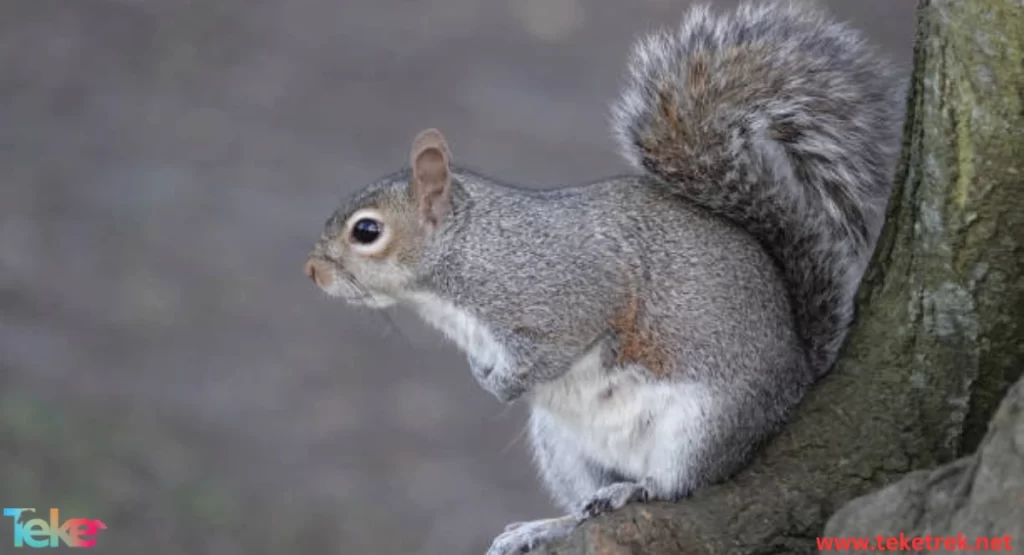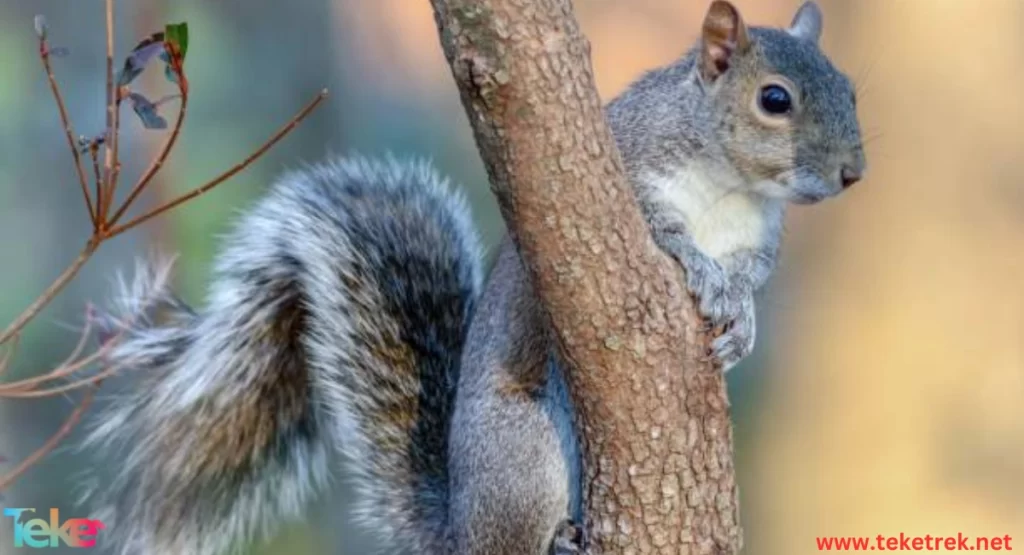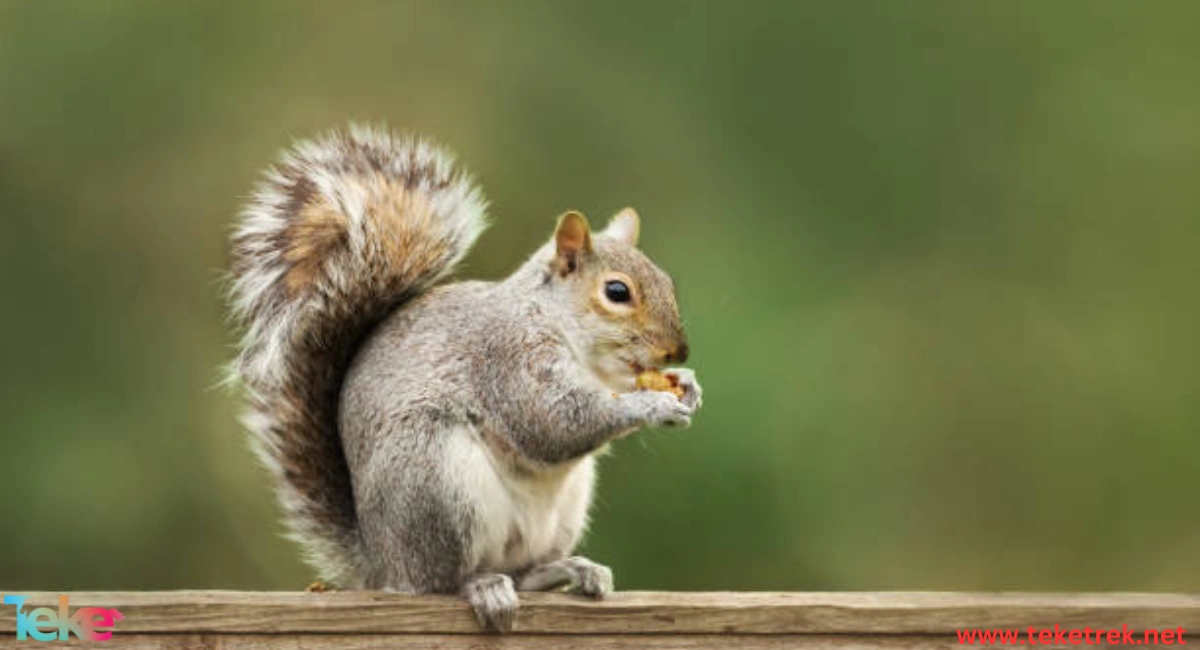The Eastern gray squirrel is an animal belonging to the rodent family and is part of the order Rodentia, class Mammalia, phylum Chordata, and kingdom Animalia.
It inhabits forested areas, especially in the regions between Maine to the south and Florida to the west.
Its scientific name is Sciuridae
Let’s learn more about it from teketrek.
Eastern gray squirrel description
The color: The Eastern gray squirrel varies seasonally, with its fur being yellowish-brown in summer and becoming denser and gray in winter.
The color variation ranges from brown, black, silver, and finally gray.
The under parts and eye rings are yellowish-brown and white, usually lighter in winter.
The ears of the Eastern gray squirrel are white in winter and in the areas adjacent to the head.
The length, the tail: It has a bushy tail that is about 18 to 25 cm long, which is approximately half of its total length of 48 to 51 cm. additionally; the tail is made up of long wavy hairs.
The weight: an adult Eastern gray squirrel weighs about one and a half pounds.
The mouth: Eastern gray squirrels have sharp incisors at the beginning of their mouths that they use for biting and cutting food.

Eastern gray squirrel habitat
Eastern gray squirrels live in the eastern United States, in the regions between Maine to the south and Florida to the west, extending to Texas.
They can be found in pine, deciduous, and oak forests, excluding Australia.
They can also survive in high polar regions and extremely dry deserts.
What do Eastern gray squirrels eat
Eastern gray squirrels feed on seeds and nuts, making them classified as herbivores. During springtime, they climb trees to feed on bark and new buds.
They diligently collect seeds and nuts like acorns and hazelnuts, storing them for winter in their habitat.
Sometimes Eastern gray squirrels also feed on insects and small vertebrates.
They have a varied diet that can include vegetables, grains, insects, eggs, plant resources, pet foods, scraps, human leftovers like cheese left in garbage.
Eastern gray squirrel life cycle
The mating season for Eastern gray squirrels begins between December and August, with a gestation period lasting forty days.
The female gives birth to 2 to 5 blind and furless young, and after six weeks, the young leave the nest.
Females typically give birth twice in one year.
Eastern gray squirrels can start mating at one year old, and as mentioned earlier, they can have two litters of young.
One litter is usually born at the end of spring, while the other is born at the end of summer.
It is known that the young Eastern gray squirrel thrives best when cared for by its mother, giving it the best chance of survival.
Eastern gray squirrel facts
These species appear very cute, enjoyable, and small in a way that makes you love having them around.
They are diurnal animals, meaning they are more active during the day unlike other rodents.
Moreover, the Eastern gray squirrel is known to be easily irritated, often aggressively interacting with each other through loud screeches, chirping, and other annoying sounds, disturbing others.
These behaviors are usually for defending food or territory.
The Eastern gray squirrel is a highly intelligent rodent that uses different sounds to communicate with other squirrels.
In addition to these sounds, these animals also signal to each other with their tails.
Eastern gray squirrels dislike certain smells and are repelled by them, such as white pepper, garlic, and black pepper.
Eastern gray squirrels plan for the future; as winter approaches, they gather food and store it in various locations.

FAQs about Eastern gray squirrels
- How long do Eastern gray squirrels live?
The lifespan of these animals varies from species to species.
In the wild, their average lifespan can range from 5 to 10 years. - What animals eat Eastern gray squirrels?
Some common predators of these animals include foxes, domestic and wild cats, dogs, weasels, cats, as well as birds of prey like eagles. Additionally, Eastern gray squirrels can be preyed upon by larger meat-eating birds. - What threats do Eastern gray squirrels face?
Eastern gray squirrels face threats from human activities such as deforestation and habitat loss, ultimately leading to their slow decline.
Loss of habitat is facilitated by urbanization and forest fires. There are also some plants that threaten the natural environment of the animal. - How do Eastern gray squirrels build their nests?
These animals build their nests themselves using branches and leaves they gather while foraging. The inner lining of their nests consists of grass and leaves.
Which is rarer, the red or gray squirrel?
Red squirrels are much rarer than gray squirrels in the UK. They are native to the region but are found in only a few areas due to reintroduction projects.
- Are gray squirrels native to Canada?
Gray squirrels are native to eastern Canada and the United States. They were introduced to Stanley Park in 1909 and to southern Vancouver Island in 1966.
.In conclusion, the Eastern gray squirrel is important to highlight the significance of this rodent in maintaining ecological balance by feeding on various animals and insects, thus reducing their population.
References:
Wikipedia





